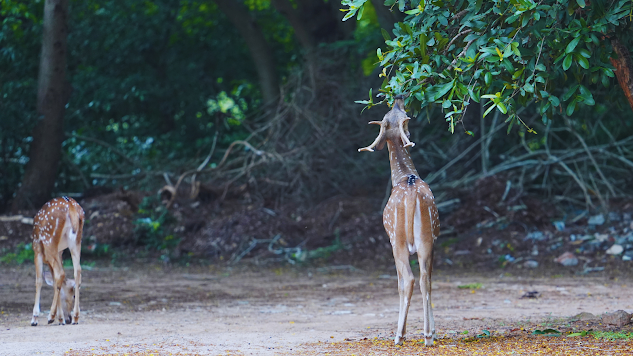.png) |
| The Peahen at MCC |
 |
| That furtive glance! That surreptitious look! That stealthy watch from a hidden perch! 😊 |
 |
| Spotted Owlets |
(c) this blogger 😊
The Woods at Madras Christian College are absolutely ‘lovely, dark and deep’ and they are quite renowned for their exceptional greenery and for their sylvan locale as well.
The Campus is a sprawling scrub jungle, of around 300 – 400 acres, and its rich natural habitat provides a rich ecosystem for diverse flora and fauna. In fact, it’s considered one of the largest scrub jungles in Asia.
Many books, journal articles, Magazine features, and newspaper features, have been published on the rich biodiversity in Campus, that is home to a wide variety of plant and animal species.
Studies have recorded over 500 plant species, including 118 different species of trees, 73 shrubs, 181 herbs, 47 climbers, 5 orchids, and 2 pteridophytes.
In fact, there are also threatened plant species like Cycas beddomi and Commiphora wightii.
As regards animals, the campus supports a significant animal population, including spotted deer (estimated 80-90), blackbucks, rabbits, wild boars, various snakes, birds (over 83 species recorded in 1939, and 80 species of butterflies), porcupines, toddy cats, and bats.
Edward Barnes and his wife Alice Barnes, who lived on campus since 1932, painstakingly shaped and nurtured the atmosphere by planting hundreds of rare plants. This legacy of preserving green cover continues with initiatives like the “Prof Edward Barnes Tree Plantation Drive”.
The college has a farm, started in 1964, which utilizes land productively for research and cultivation. It grows horticultural crops (mango, sapota, papaya, guava, banana, amla) and various short-term vegetable crops (bhendi, brinjal, pumpkin, etc.).
Organic farming practices are employed, and produce is supplied to the college community. The farm also houses green projects like a solar power plant and a sewage treatment plant, contributing to sustainability.
MCC has a dedicated student-led “Scrub Society” and Wildlife Conservation Club, dedicated to safeguarding the greenery of the campus. They organize activities like campus walks, bird watching, tree census, tree planting, and campus cleaning to encourage environmental appreciation and conservation.
Sustainability is one of the key USPs of our College, demonstrated through a strong commitment to being a “green campus”.
The College meets 50% of its power needs through solar energy, has a modernized Sewage Treatment Plant (STP), and actively promotes waste management practices to achieve a “Zero Waste Institution” goal.
The Woods offer a truly green and natural environment, meticulously preserved and actively managed, providing a unique and enriching experience for its students and dwellers as well.
Thought of presenting just
a few of the many eminent naturalists in India, who had graduated from MCC.
John C (Jacob)
Johncee’s Bush Frog Raorchestes johnceei Zachariah et al., 2011
Professor John C. (Johnsi) Jacob (1936–2008) was born in Kerala, India and was one of the pioneers of the environmental movement there.
He studied zoology at Madras Christian College, where he was awarded his bachelor’s degree. He worked at Payanur College until retirement (1972–1992), eventually becoming Head of the Zoology Department.
An ardent naturalist, he devoted his life to conserving the biodiversity of the Western Ghats.
He wrote a number of books including Urangunnavarude Thazhvaraka. The etymology reads: ‘The species is named after Late Prof. John C. Jacob (who was popularly known as ‘Johncee’), in honor of his nature education movement initiatives in Kerala.’ At least one plant species is named after him.
Source
Beolens, Bo et al. The Eponym Dictionary of Amphibians. Exeter: Pelagic Publishing, 2013.
Professor C R Narayan Rao
Professor C R Narayan Rao (1882–1960)
was an Indian herpetologist and zoologist.
He was educated at Madras Christian College and, after gaining his diploma, became a teacher in Coimbatore and Ernakulam.
He moved to Central College, Bangalore, University of Mysore, where he was Head, Department of Zoology, which he created, until his retirement (1909–1937). He co-founded (1932) and was first Editor of Current Science.
He was influential in the decision that led to the foundation of the Indian Academy of Sciences. His speciality was frogs and their taxonomy.
Rao’s Bush Frog Micrixalus swamianus Rao, 1937
[Alt. Ramaswami’s Bush
Frog]
Rao’s Lateral-eyed Frog
Nyctibatrachus sylvaticus Rao, 1937
[Alt. Forest Night Frog]
Rao’s Pale Brown Toad
Duttaphrynus brevirostris Rao, 1937
Narayan’s Caecilian
Uraeotyphlus narayani Seshachar, 1939
[Alt. Kannan Caecilian]
Source
Beolens, Bo et al. The Eponym Dictionary of Amphibians. Exeter: Pelagic Publishing, 2013.
to be continued...

.png)

.png)

.png)
.png)


No comments:
Post a Comment